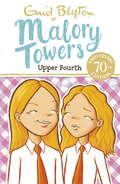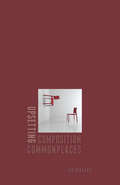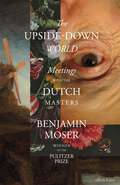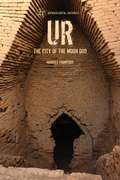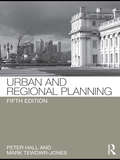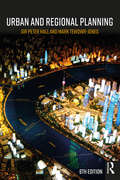- Table View
- List View
Upgrading Physics Education to Meet the Needs of Society
by Maurício PietrocolaNations around the globe consider physics education an important tool of economic and social development and currently advocate the use of innovative strategies to prepare students for knowledge and skills acquisition. Particularly in the last decade, a series of revisions were made to physics curricula in an attempt to cope with the changing needs and expectations of society. Educational transformation is a major challenge due to educational systems’ resistance to change. Updated curriculum content, pedagogical facilities (for example, computers in a school), new teaching and learning strategies and the prejudice against girls in physics classes are all issues that have to be addressed. Educational research provides a way to build schemas and resources to promote changes in physics education. This volume presents physics teaching and learning research connected with the main educational scenarios.
Uplifting Gender and Sexuality Education Research (Palgrave Studies in Gender and Education)
by Tiffany Jones Leanne Coll Lisa Van Leent Yvette TaylorThis book showcases and celebrates the work of Gender and Sexuality Education scholars in order to challenge current negative interpretations of the field, and work towards new shared visions. The editors and contributors call for, affirm and offer examples of pathways towards exciting and dynamic collaborative work in Gender and Sexuality in Education. In doing so, they also acknowledge the various complexities of this field, and detail the context-specific barriers faced by academics and activists. Drawing upon a range of global case studies, this book sets out information and advice from cross-sector experts to set an agenda of mutual supportiveness, and to smooth pathways for future collaboration. Above all, this book is a call to action to uplift the field – and each other – in challenging environments. This ground-breaking book will be of interest and value to scholars of Gender and Sexuality Education research.
Upon What Does the Turtle Stand?: Rethinking Education for the Digital Age
by Aharon Aviram Janice RichardsonThis book brings together the reflections of independent researchers from around the world. Sixteen authors from fourteen countries present their views on the use of information and communication technology (ICT) in education, offering valuable insights through the examination of current issues relevant to the future of education. What will education be in tomorrow’s world? How can ICT be used without rendering education a purely technical process? How can we succeed the renovation of educational subjects without transforming them into technical objects? The introductory chapter of this publication guides us into the essays through a classification organized by the editors to illustrate different attitudes to technologies: • The ‘Globalizers’ see the integration of ICT and education as a means of enhancing the competitiveness of their society in a global economy; • The ‘Reformists’ see it as a means of bringing about significant change in didactics in the various disciplines, and even in the ‘basics’ of education; • The ‘Humanists’ consider technologies as possible catalysts for changing the aims and values of education from learni- oriented to humanistic; • The ‘Heretic’ sees values and aims as being determined exclusively by technology, and economy and culture as s- products of the technology-guided process. He therefore does not see any sense in interrogations as to which aims should guide us in integrating technology with education. Obviously, some arguments stretch across all four categories without completely matching any so-called type.
Upper Fourth: Book 4 (Malory Towers #Vol. 4)
by Enid BlytonWelcome to Malory Towers, where there's more to life than lessons!Darrell Rivers is delighted to be Head Girl of her form - and this year her sister Felicity joins Malory Towers too. Most of the time Darrell couldn't be prouder of Felicity, but she's much less keen on her sister's trouble-making new friend. With twins Connie and Ruth also causing problems, Darrell's first term in charge is a big challenge... Between 1946 and 1951, Enid Blyton wrote six novels set at Malory Towers. Book 4 was first published in 1949. This edition features the classic text and is unillustrated.*Malory Towers ®, Enid Blyton ® and Enid Blyton's signature are registered trade marks of Hodder & Stoughton Limited. No trade mark or copyrighted material may be reproduced without the express written permission of the trade mark and copyright owner.
The Upper Secondary School: A Comparative Survey
by Lewis SpoltonThe Upper Secondary School: A Comparative Survey presents the evolutionary stages through which educational systems develop as industrialism advances. This book discusses the various implications of the progress in the society whereby each has significance for education. Organized into 15 chapters, this book begins with an overview of the problems of upper secondary education and describes the actual and planned solutions in different countries. This text then investigates critically the progress that has been achieved and points out the ways in which the prospective of the present system is being under used. Other chapters consider the balance of general and special studies. This book discusses as well the system of further education and documents its achievements as well as its inefficiencies. The final chapter deals with the system of education in Spain, which has a low level of educational provision. This book is a valuable resource for sociologists, educators, and psychologists.
Uprooting Bias in the Academy: Lessons from the Field
by Linda F. Bisson Laura Grindstaff Lisceth Brazil-Cruz Sophie J. BarbuThis open access book analyzes barriers to inclusion in academia and details ways to create a more diverse, inclusive environment. It describes the implementation of UC Davis ADVANCE, a grant program funded by the National Science Foundation, to increase the hiring and retention of underrepresented scholars in the STEM fields (science, technology, engineering and mathematics) and foster a culture of inclusion for all faculty. It first describes what the barriers to inclusion are and how they function within the broader society. A key focus here is the concept of implicit bias: what it is, how it develops, and the importance of training organizational members to recognize and challenge it. It then discusses the limitations of data collection that is guided by the convention assumption that being diverse automatically means being inclusive. Lastly, it highlights the importance of creating a collaborative, interdisciplinary, and institution-wide vision of an inclusive community.
Uprooting Sexual Violence in Higher Education: A Guide for Practitioners and Faculty
by Amy Murphy Brian Van BruntWith national conversation turned toward sexual assault on college campuses, knowing how to identify, prevent, and address these incidents in a safe, and productive way is essential for administrators and faculty. Uprooting Sexual Violence in Higher Education provides colleges and universities with a foundational understanding of twelve risk factors related to sexual assault, stalking, and intimate partner violence. By presenting a blend of theory, research, and the personal reflections of professionals ‘on the front lines,’ this book provides insights into the motivations, attitudes, and behaviors behind sexual assault on campus, as well as strategies for mitigating these risk factors in an effort to tailor prevention efforts. Whether you are seeking a way to navigate the recent regulations on sexual violence from the federal government or merely wish to safeguard the welfare of students on your campus, this book will provide the neccesary, and invaluable foundation you need to empower, respect, and support all students.
Uprooting Sexual Violence in Higher Education: A Guide for Practitioners and Faculty
by Amy Murphy Brian Van BruntWith national conversation turned toward sexual assault on college campuses, knowing how to identify, prevent, and address these incidents in a safe, and productive way is essential for administrators and faculty. Uprooting Sexual Violence in Higher Education provides colleges and universities with a foundational understanding of twelve risk factors related to sexual assault, stalking, and intimate partner violence. By presenting a blend of theory, research, and the personal reflections of professionals ‘on the front lines,’ this book provides insights into the motivations, attitudes, and behaviors behind sexual assault on campus, as well as strategies for mitigating these risk factors in an effort to tailor prevention efforts. Whether you are seeking a way to navigate the recent regulations on sexual violence from the federal government or merely wish to safeguard the welfare of students on your campus, this book will provide the neccesary, and invaluable foundation you need to empower, respect, and support all students.
Upsetting Composition Commonplaces
by Ian BarnardIn Upsetting Composition Commonplaces, Ian Barnard argues that composition still retains the bulk of instructional practices that were used in the decades before poststructuralist theory discredited them. While acknowledging that some of the foundational insights of poststructuralist theory can be difficult to translate to the classroom, Barnard upends several especially intransigent tenets that continue to influence the teaching of writing and how students are encouraged to understand writing. Using six major principles of writing classrooms and textbooks—clarity, intent, voice, ethnography, audience, and objectivity—Barnard looks at the implications of poststructuralist theory for pedagogy. While suggesting some evocative poststructuralist pedagogical practices, the author focuses on diagnosing the fault lines of composition's refusal of poststructuralism rather than on providing "solutions” in the form of teaching templates. Upsetting Composition Commonplaces addresses the need to more effectively engage in poststructuralist concepts in composition in an accessible and engaging voice that will advance the conversation about relations between the theory and teaching of writing.
The Upside-Down World: Meetings with the Dutch Masters
by Benjamin MoserThe Pulitzer Prize-winning biographer turns his eye to the seventeenth-century Dutch Golden Age Twenty years ago, Benjamin Moser followed a love affair to an ancient Dutch town. In order to make sense of this new place, he threw himself into the Dutch museums. Soon, he found himself unearthing the strange, inspiring and sometimes terrifying stories of the artists who shaped one of the most luminous moments in the history of human creativity, the Dutch Golden Age.As he explored the hidden world of the Dutch Masters (and one Mistress), Moser met a crowd of fascinating personalities: the stormy Rembrandt, the intimate Ter Borch, the mysterious Vermeer. Through their art, he got to know their country, too: from Pieter Saenredam's translucent churches to Paulus Potter's muddy barnyards, and from Pieter de Hooch's cozy hearths to Jacob van Ruisdael's tragic trees. Over the years, Moser found himself on increasingly intimate terms with these centuries-dead artists, and found that they, too, were struggling with the same questions he was. Why do we make art? What is art, anyway - and what is an artist? What does it mean to succeed as an artist, and what does it mean to fail?The Upside-Down World is an invitation to ask these questions, and to turn them on their heads: to look, and then to look again. It is a brilliant, colourful and learned book for anyone, whether lifelong scholar or curious tourist, who has ever felt the lure of the Dutch galleries. It shows us art, and artists, as we have never seen them before.
Upskill: 21 keys to professional growth
by Chris WatsonBrimming with punchy, practical ideas to improve your day-to-day effectiveness, Upskill: 21 keys to professional growth is the definitive guide to developing the adaptive skills essential for success at work. In Upskill, adaptive skills specialist Chris Watson delivers a dynamic snapshot of easy-to-access development possibilities – providing you with: 840 user-friendly tools and techniques reflecting the latest thinking on how to extend capability, boost professional growth and take charge of your career; a rich resource of reliable solutions, grouped around the twenty-one adaptive skills most valued by today’s employers – including creativity, collaboration and communication; an abundance of proven approaches, topical insights, time-saving apps and inspirational videos, as well as helpful signposts to relevant quotes, books and other resources. Each chapter focuses on one of the twenty-one skills, and begins with examples of how the individual skills – which can be practised and refined throughout a career, and have all been shown to be associated with greater operational agility – may be observed in the work environment. This brief introduction is then followed by forty practical ideas to develop the performance of people. Although there is no formal hierarchy to the list of suggestions, all of the ideas have been categorised into three inter-related clusters for ease of use – encompassing ideas for personal development, for delivering results and for long-term gain. Within each of the three clusters, all of the ideas for professional growth have been laid out in terms of how they can help you respond and adjust to the requirements of your role and the ever-changing world of work. Some of the suggestions are tools – apps, templates, downloads and inventories – which can be picked up and used/introduced straightaway. Some of the suggestions are techniques – methods, approaches and procedures – for you to try out, investigate and explore. The final set of suggestions indicate where to look for further inspiration – including films, podcasts, related research and a wide range of suggested reading materials. The majority of the hints, tips and techniques can be actioned without having to access any external support or invest in any additional outlay, and are as useful for new starters in an organisation as they are for experienced managers. Suitable for anyone who is committed to developing themselves and their colleagues, but may not have the time, the resources, the budget or the inspiration to know where to start.
Upstart: The case for raising the school starting age and providing what the under-sevens really need
by Sue PalmerWhy does Britain and its former colonies send children to school as young as four and five, when in eighty-eight per cent of the world the starting age is six or seven? Sue Palmer, author of bestselling Toxic Childhood, uncovers the truth: it's not because of what's best for children, but historical accident and economics. Palmer examines research ranging from neurological science to educational data, and shows that under-sevens gain most -- educationally, physically, socially and psychologically -- from not being stuck behind a desk. Upstart puts forward a passionate case for Britain adopting a proper 'kindergarten' stage that recognises what under-sevens really need. With clarity, ease and vigour, Palmer describes a different way of doing early years education that would have huge benefits both for individual children, and for our nation.
Upstart: Friends, Foes And Founding A University
by Ed Walsh Kieran FaganEd Walsh returned to Ireland in 1970 to blunder into setting up an institute of education. He found a decaying mansion on a riverside site, gathered talented young people and secured funding from the World Bank and European Investment Bank to build what became the University of Limerick. Along the way, Ed made powerful enemies as he challenged official cant, traditional academics and clerical humbug. This is an inspiring, frank and often funny memoir by a passionate educational leader.
Ur: The City of the Moon God (Archaeological Histories)
by Harriet CrawfordThe ancient Mesoptamian city of Ur was a Sumerian city state which flourished as a centre of trade and civilisation between 2800–2000 BCE. However, in the recent past it suffered from the disastrous Gulf war and from neglect. It still remains a potent symbol for people of all faiths and will have an important role to play in the future.This account of Ur's past looks at both the ancient city and its evolution over centuries, and its archaeological interpretation in more recent times. From the 19th century explorers and their identification of the site of Mukayyar as the Biblical city of Ur, the study proceeds to look in detail at the archaeologist Leonard Woolley and his key discoveries during the 1920s and 30s. Using the findings as a framework and utilising the latest evidence from environmental, historical and archaeological studies, the volume explores the site's past in chronological order from the Ubaid period in the 5th millennium to the death of Alexander. It looks in detail at the architectural remains: the sacred buildings, royal graves and also the private housing which provides a unique record of life 4000 years ago. The volume also describes the part played by Ur in the Gulf war and discusses the problems raised for archaeologists in the war's aftermath.
Ur: The City of the Moon God (Archaeological Histories)
by Harriet CrawfordThe ancient Mesoptamian city of Ur was a Sumerian city state which flourished as a centre of trade and civilisation between 2800–2000 BCE. However, in the recent past it suffered from the disastrous Gulf war and from neglect. It still remains a potent symbol for people of all faiths and will have an important role to play in the future.This account of Ur's past looks at both the ancient city and its evolution over centuries, and its archaeological interpretation in more recent times. From the 19th century explorers and their identification of the site of Mukayyar as the Biblical city of Ur, the study proceeds to look in detail at the archaeologist Leonard Woolley and his key discoveries during the 1920s and 30s. Using the findings as a framework and utilising the latest evidence from environmental, historical and archaeological studies, the volume explores the site's past in chronological order from the Ubaid period in the 5th millennium to the death of Alexander. It looks in detail at the architectural remains: the sacred buildings, royal graves and also the private housing which provides a unique record of life 4000 years ago. The volume also describes the part played by Ur in the Gulf war and discusses the problems raised for archaeologists in the war's aftermath.
Urban and Regional Planning
by Peter Hall Mark Tewdwr-JonesThis is the fifth edition of the classic text for students of urban and regional planning. It gives an historical overview of the developments and changes in the theory and practice of planning, throughout the entire twentieth century. This extensively revised edition follows the successful format of previous editions: it introduces the establishment of planning as part of the public health reforms of the late nineteenth century and goes on to look at the insights of the great figures who influenced the early planning movement, leading up to the creation of the post-war planning machine national and regional planning, and planning for cities and city regions, in the UK, from 1945 to 2010, is then considered. Specific reference is made to the most important British developments in recent times, including the Single Regeneration Budget, English Partnerships, the devolution of Scotland, Wales and Northern Ireland, the establishment of the Mayor of London and the dominant urban sustainability paradigm planning in Western Europe, since 1945, now incorporating new material on EU-wide issues, as well as updated country specific sections planning in the United States, since 1945, now discussing the continuing trends of urban dispersal and social polarisation, as well as initiatives in land use planning and transportation policies finally the book looks at the nature of the planning process at the start of the twenty-first century, reflecting briefly on shifts in planning paradigms since the 1960s and going on to discuss the main issues of the 1990s and 2000s, including sustainability and social exclusion and looking forward to the twenty-first century.
Urban and Regional Planning
by Peter Hall Mark Tewdwr-JonesThis is the fifth edition of the classic text for students of urban and regional planning. It gives an historical overview of the developments and changes in the theory and practice of planning, throughout the entire twentieth century. This extensively revised edition follows the successful format of previous editions: it introduces the establishment of planning as part of the public health reforms of the late nineteenth century and goes on to look at the insights of the great figures who influenced the early planning movement, leading up to the creation of the post-war planning machine national and regional planning, and planning for cities and city regions, in the UK, from 1945 to 2010, is then considered. Specific reference is made to the most important British developments in recent times, including the Single Regeneration Budget, English Partnerships, the devolution of Scotland, Wales and Northern Ireland, the establishment of the Mayor of London and the dominant urban sustainability paradigm planning in Western Europe, since 1945, now incorporating new material on EU-wide issues, as well as updated country specific sections planning in the United States, since 1945, now discussing the continuing trends of urban dispersal and social polarisation, as well as initiatives in land use planning and transportation policies finally the book looks at the nature of the planning process at the start of the twenty-first century, reflecting briefly on shifts in planning paradigms since the 1960s and going on to discuss the main issues of the 1990s and 2000s, including sustainability and social exclusion and looking forward to the twenty-first century.
Urban and Regional Planning
by Peter Hall Mark Tewdwr-JonesThis is the sixth edition of the classic text for students of urban and regional planning. It gives a historical overview of the developments and changes in the theory and practice of planning throughout the entire 20th and first part of the 21st centuries. The extensively revised edition incorporates the most important developments in recent times: debates on economic rebalancing and national infrastructure including high speed rail, energy, millennium projects, Celtic devolution, European influence, impact of London on nation. A new chapter "Planning for cities and city regions 1990-2017": includes new material on housing, localism, neighbourhood planning, privatisation, city modernism, reform, Devo and city deals and metro mayors. Urban and Regional Planning will be invaluable to undergraduate as well as postgraduate Planning students. It will prove useful in a variety of built environment areas such as Architecture, Landscape Architecture, Urban Design, Real Estate where planning is taught.
Urban and Regional Planning
by Peter Hall Mark Tewdwr-JonesThis is the sixth edition of the classic text for students of urban and regional planning. It gives a historical overview of the developments and changes in the theory and practice of planning throughout the entire 20th and first part of the 21st centuries. The extensively revised edition incorporates the most important developments in recent times: debates on economic rebalancing and national infrastructure including high speed rail, energy, millennium projects, Celtic devolution, European influence, impact of London on nation. A new chapter "Planning for cities and city regions 1990-2017": includes new material on housing, localism, neighbourhood planning, privatisation, city modernism, reform, Devo and city deals and metro mayors. Urban and Regional Planning will be invaluable to undergraduate as well as postgraduate Planning students. It will prove useful in a variety of built environment areas such as Architecture, Landscape Architecture, Urban Design, Real Estate where planning is taught.
Urban and Regional Planning Education: Learning for India
by Ashok Kumar Diwakar S. Meshram Krishne GowdaThis is the first volume exclusively dedicated to planning education, with a focus on India and learning from global experiences for India. Prior to the 1990s, planning education in India was largely confined to national and local economic concerns. Within a globalized scenario, such pedagogies and theories have become outmoded. With new concerns emerging in planning, new pedagogical tools and theorizations need to be developed within planning curricula to provide today’s planners with the wherewithal to adapt to changing and globalizing cities and regions in India. Therefore, the eminent contributors to this volume deal exclusively and comprehensively with planning education in a globalized context. Divided into four thematic sections, this volume provides a comprehensive view of planning education in India, with focus on: • The trajectory of planning education in India.• The kinds of knowledge used for teaching in Indian planning schools, and whether some sort of integration of diverse knowledges is achieved. • The ethical foundations of urban and regional planning in Indian planning schools. • The role of international planning perspectives in providing new insights for Indian planning education. Comprehensive and topical, this volume is of interest to academics and researchers from planning institutes, urban and regional planners and policy makers, as well as architects, social geographers and economists.
Urban and Rural Decay Photography: How to Capture the Beauty in the Blight
by J. Dennis ThomasIf you are a photographer who sees the beauty in abandoned buildings, crumbling facades, and preserving a fading history, and who also has a love of urban exploration, you have stumbled on a must-have for your photographic library. Urban and Rural Decay Photography offers expert tips and techniques for capturing breathtaking photographs of your favorite decay scenes, whether in urban or rural settings. Author J. Dennis Thomas guides you through the history of decay photography, shows you what equipment you will need, and discusses digital, film and HDR capture and composition. The book addresses which artistic considerations work best for the kinds of shots that capture a moment and convey a story. He also provides you with important safety advice and matters of the law when entering and working with decaying structures. Chock full of inspiring images that will ignite your creativity and your passion for decay photography, Urban and Rural Decay Photography is just the book you need to get you out and discovering your newest urban or rural exploration adventure.
Urban and Rural Decay Photography: How to Capture the Beauty in the Blight
by J. Dennis ThomasIf you are a photographer who sees the beauty in abandoned buildings, crumbling facades, and preserving a fading history, and who also has a love of urban exploration, you have stumbled on a must-have for your photographic library. Urban and Rural Decay Photography offers expert tips and techniques for capturing breathtaking photographs of your favorite decay scenes, whether in urban or rural settings. Author J. Dennis Thomas guides you through the history of decay photography, shows you what equipment you will need, and discusses digital, film and HDR capture and composition. The book addresses which artistic considerations work best for the kinds of shots that capture a moment and convey a story. He also provides you with important safety advice and matters of the law when entering and working with decaying structures. Chock full of inspiring images that will ignite your creativity and your passion for decay photography, Urban and Rural Decay Photography is just the book you need to get you out and discovering your newest urban or rural exploration adventure.
Urban and Rural Students’ Access to Elite Chinese Universities: Contextualising Bourdieu in China (Education and Society in China)
by Yanru XuStudies have shown the disparities between urban and rural students accessing elite universities in China, a phenomenon which Xu explores in this groundbreaking book. She argues that such disparities follow a Bourdieusian capital approach showing how urban parents increased capital benefits the advancement of their children’s education. This book qualitatively explores urban and rural students’ life stories prior to their elite university entry through interviews with both parents and students. It seeks a ‘reflective reappropriation’ of Bourdieu’s notions in understanding Chinese urban and rural students’ academic success. In addition to the implications for Chinese domestic and international scholars’ understanding of the mediating role of rurality, higher education access and Chinese policymakers’ ongoing initiatives on the hukou reform, this book promotes the global reflections on the development and promotion of national analytical concepts in understanding contextualised educational issues to advance knowledge co-production. An engaging text that will be of interest to students and researchers across the fields of global higher education and sociology of education in East Asia, as well as policymakers working towards increased participation, equity, and social justice in higher education worldwide.
Urban and Rural Students’ Access to Elite Chinese Universities: Contextualising Bourdieu in China (Education and Society in China)
by Yanru XuStudies have shown the disparities between urban and rural students accessing elite universities in China, a phenomenon which Xu explores in this groundbreaking book. She argues that such disparities follow a Bourdieusian capital approach showing how urban parents increased capital benefits the advancement of their children’s education. This book qualitatively explores urban and rural students’ life stories prior to their elite university entry through interviews with both parents and students. It seeks a ‘reflective reappropriation’ of Bourdieu’s notions in understanding Chinese urban and rural students’ academic success. In addition to the implications for Chinese domestic and international scholars’ understanding of the mediating role of rurality, higher education access and Chinese policymakers’ ongoing initiatives on the hukou reform, this book promotes the global reflections on the development and promotion of national analytical concepts in understanding contextualised educational issues to advance knowledge co-production. An engaging text that will be of interest to students and researchers across the fields of global higher education and sociology of education in East Asia, as well as policymakers working towards increased participation, equity, and social justice in higher education worldwide.
Urban Design and Planning for Age-Friendly Environments Across Europe: Developing Healthy and Therapeutic Living Spaces for Local Contexts (Future City #19)
by Elisa Pozo Menéndez Ester Higueras GarcíaThis book represents a multidisciplinary and international vision across different countries in Europe that are facing similar challenges about ageing and quality of life in present cities. It is divided in three main topics from the global context of health in cities and reduction of health inequities to the current research of different study cases, focusing on residential models and the relationship with the built environment. The third chapter illustrates best practices with some study cases from different cities in Europe. Friendlier environments for older people come together with the need of innovation, smart and updated technologies, healthier environments and mitigation of climate change. Health re-appears nowadays as one of the priorities for urban planning and design, not only for the communicable diseases and the effect of the pandemics, but also for the non-communicable diseases, that were also triggering the wellbeing and equity of our cities. Indeed, the Covid-19 pandemic has highlighted health inequities and vulnerabilities of those areas of the city that were already deprived and facing other health problems, such as obesity, diabetes, social isolation, respiratory problems or mental health issues, specifically applying for vulnerable groups. Older adults have been one of the most affected groups from the pandemic’s threats and derived consequences. In this context, the care crisis arises intertwined with the design and planning of our cities, where there is an urgent need to regenerate our environments with a perspective of sustainability, inclusion, and health prevention and promotion. From the global urban challenges to the specific contextualisation of each city and study cases, each chapter offers an updated insight of the main questions that we should consider to address urban planning and design from the perspective of ageing and social inclusion in European cities.



